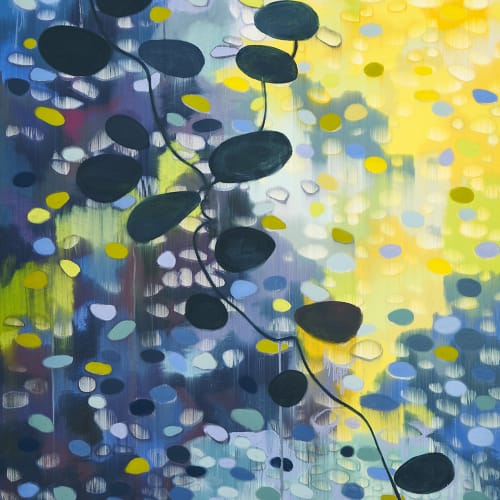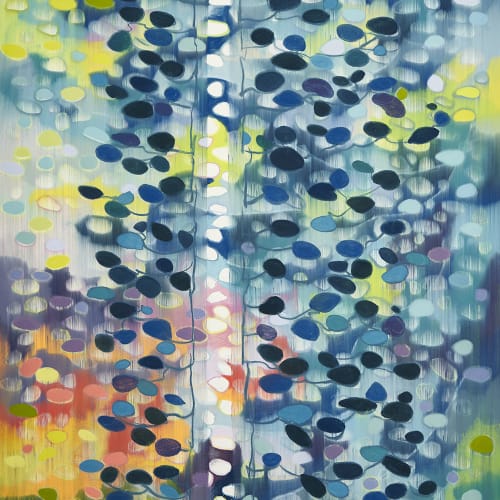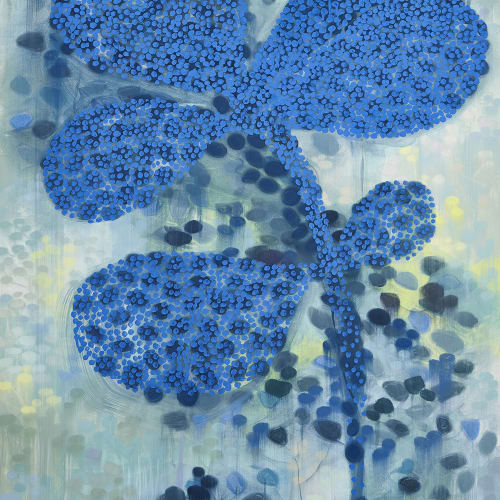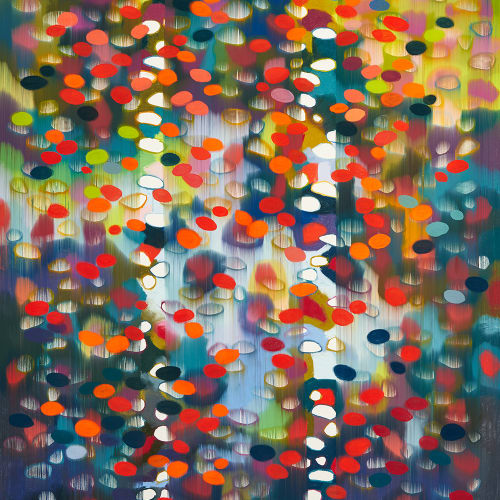Hen Coleman’s intricate and highly worked drawings, dripping and dappled in colour, are to feature in our next solo show Yonder. It is a beautiful, reflective body of work that breathes and beats nature’s rhythms.
Landscape is central to Hen Coleman's work, with a significant influence being her childhood in Venezuela, living between oil camps on the shores of Lake Maracaibo and the valley city of Caracas. “We lived in a sort of contained wilderness, free but always with the sense of looking out at the world. An expat life is by nature a life in exile”. The yonder of those 18 years was a tropical landscape of lake, sea and mountain; with indelible images of standing above the cloud line in the Andes or swimming in the oily water of the lake. The ground around the lake had sunk below sea level due to oil extraction. We accepted that reversed world”.
This strange inversion of her understanding of landscape is distinctive and one that still holds a fascination for her as a working artist today. It is here, in the blurred, slivered edges of a place, looking out from within, that she observes the world as “it dissolves from one place, thing or matter, to another”. This could be at the taming, boundary fence of camp as it melts into the backdrop of the wild beyond, at the lake shoreline where it shifts and changes from liquid into land or where the shade and darkness of a wood meets the shade-less light of sky. As she says of her work, “These aren’t theatrical scenarios, they’re intuitive, a description of how it feels to be both immersed in and observing the memory of a place”.
Using pastels and charcoal allows her to conjure this ‘dissolving’ effect. They are close mediums, matt and dense, making the surface of the paper unsure of itself. The addition of water to the materials brings the resulting drawings closer to paintings giving movement and depth, creating marks which blur the depth of field and blend foreground into background. She comments that “it’s a mirage. I’m not quite sure where the surface sits”. It also has a relationship to her method of printmaking. “When I draw, I think in distances, creating three or four layers as I build the image”. These are important, particular and recognisable features of Hen’s work.
This new work featured in Yonder sees Hen exploring a much wider colour pallette. She comments about her use of charcoal “I feel I understand it as a medium. The limitation of monochrome is also a freedom; it allows you to concentrate entirely on what the tone and density of a black can do. Last summer, a two month residency in France gave me the chance to challenge that and see what colour can do in the work. It gave me time to experiment in a different but equally extraordinary landscape.”
Making things has been a lifelong interest for Hen, although she was 30 before studying Fine Art . She comments that she was always a ‘maker’. “My mother and I were keen crafters! She made theatre costumes for the Caracas Theatre Club, taught me to sew and knit, and we papier-mâché’d a whole lot of stuff around the house!” Hen went straight into work at 18 for practical reasons, returning to study Fine Art at Farnham University after a successful career in writing and design for a number of London advertising agencies. “I had one really influential tutor there who set me on the path to an MA in printmaking at the Royal College of Art. The experience of that MA sealed the deal”. Fifteen years later, as a working artist she continues to be involved in education as a part-time print tutor at the Royal Academy Schools. “It’s a very different proposition to the RCA there. I’d say it’s a unique environment in the choices of MA courses”.
We talk about the ebbs and flows of a family life, studying and teaching and their compatibility with work as an artist. “Parenting is a creative act. Teaching is too. In many ways it draws from your artistic energy so the years when the children were young and I was teaching more were definitely interesting. Taking time to work is easier now. I live in the middle of woodland, surrounded by an English bucolic landscape which is still in some ways foreign territory to me. I’m also now able to take part in residencies and projects which include travel and time away. These are big changes and they bring that expansion into the work.”
I ask her which artists inspire her. “There’s the obvious canon of landscape painting but I’m probably more interested by how it appears obliquely: the rock formations in a Pisanello fresco or a Mantegna painting, the wrapped islands of Christo and Jean-Claude, my parent’s collection of Willow Pattern and their table mats of midlands hunting scenes. With my own family I spent several years in Barcelona acting as a guide to Gaudi, Tapies and Miro. I’ll enjoy a Peter Doig painting for the same reason as I do a Samuel Palmer etching or a watercolour by Paul Klee. When you engage with someone else’s work it’s often about recognising your own interest. I try to make work that’s not afraid to be beautiful or viewed as traditional. It’s a contemporary reflection of a sense of place”.
It is this that comes through in the works. These are joyful pieces about beauty in landscape, in its sometimes unreached places and moments. Hen has ventured into the yonder and captured that feeling in her deeply-layered, radiant and expressive pieces.
Interview with Kerry Betsworth, February 2018




